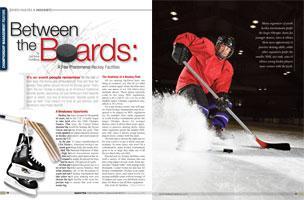
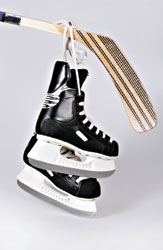 It's an event people remember for the rest of their lives. The family gets all bundled up. They don their fan jerseys. They gather around the ice for the big game. That's right, the ice. Hockey is edging up on America's traditional favorite sports, becoming not just America's third favorite sport to watch, but one of Americans' favorite sports to play as well. That means it's time to get familiar with America's new frosty favorite.
It's an event people remember for the rest of their lives. The family gets all bundled up. They don their fan jerseys. They gather around the ice for the big game. That's right, the ice. Hockey is edging up on America's traditional favorite sports, becoming not just America's third favorite sport to watch, but one of Americans' favorite sports to play as well. That means it's time to get familiar with America's new frosty favorite.
A Breakaway Opportunity
Hockey has been around for thousands of years, but in the U.S., it really began to take hold after the 1980 Olympic Games. That year, the United States shocked the world by beating the Soviet Union and taking home the gold. That event sparked an unprecedented increase in hockey popularity and participation across the U.S.
In the past 15 years, membership in USA Hockey, American hockey's national governing body, has nearly doubled. The National Federation of State High School Associations reports that ice hockey participation has increased by nearly 40 percent for boys and by nearly 200 percent for girls.
All that participation has given rise to a lot of new facilities across America. And when planning one of the thousands of youth and adult hockey tournaments that take place each year, making sure you choose the right facility is the most important way to ensure that your event scores big.
The Anatomy of a Hockey Rink
All ice skating facilities have one thing in common: ice. But all ice rinks aren't created equal. Some facilities have only one sheet of ice, but others have multiple sheets. These sheets typically come in two sizes, NHL regulation, which is 85 x 200 ft. (26 x 61 m) or the slightly larger Olympic regulation size, which is 30 x 60 m.
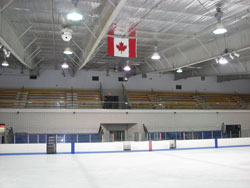 For some hockey events, size will matter. Some hockey tournaments may be required to be played on NHL regulation ice, for example. Also, many organizers of youth hockey tournaments prefer the larger Olympic sheets for younger skaters, since it allows them more opportunity to practice skating skills, while other organizers prefer the smaller NHL size rink, since it allows young hockey players more contact with the puck.
For some hockey events, size will matter. Some hockey tournaments may be required to be played on NHL regulation ice, for example. Also, many organizers of youth hockey tournaments prefer the larger Olympic sheets for younger skaters, since it allows them more opportunity to practice skating skills, while other organizers prefer the smaller NHL size rink, since it allows young hockey players more contact with the puck.
The best way to choose the right size ice for your event is to get to know your participants. In some cases, size won't be a consideration: many hockey tournaments grow to be so large they make use of all the ice sheets they can find.
Beyond just ice, hockey facilities come with a variety of other features that can have a big impact on your event. Some arenas have "feature rinks" with seating in the thousands. Locker rooms are also key for hockey tournaments. Hockey is an equipment-heavy sport, and when you're expecting multiple teams with an average of 10 players per team, you definitely need a place for them to put all their equipment.
Also look for facilities to come with a range of perks, from pro shops and training facilities to restaurants with fireplaces where hockey moms and dads can kick back. All of these can be great features to draw participants to your event, but when you're trying to create an event with big appeal, what's outside the risk is just as important.
Hockey tournament regulations typically dictate that players spend a certain amount of time off the ice between games. That means locating your event close to recreational resources like malls and parks can add enormous appeal. Also consider transportation and proximity to restaurants and lodging, particularly if you want to draw participants from out of town.
Finding a Hockey Home
Sometimes, when choosing a location for your hockey tournament, you choose the ideal facility, but then your hockey event grows well beyond its original home. No one knows that better than John Madrid, tournament director for the Pikes Peak Presidents Day tournament.
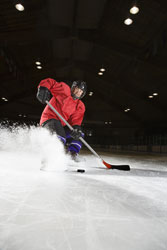 "Oh, it started out small," says Madrid. "The very first tournament we had 16 teams, but it has grown exponentially over the years."
"Oh, it started out small," says Madrid. "The very first tournament we had 16 teams, but it has grown exponentially over the years."
Today the Pikes Peak Presidents Day tournament, in its32nd year, is the longest-running youth hockey tournament in America and one of the largest, too. Presidents Day weekend there is no ice to be had in Colorado Springs, Colorado, because Madrid and his hockey players are using every inch of it.
Of course, you could move your event to a location with a giant facility, but even the largest facilities would have trouble accommodating the Pikes Peak tournament in just one weekend. Also, community support is just as important as facilities, and Madrid is happy right where he is.
"Having kids come out and play good competitive hockey, that's what we're all about," says Madrid. "The Colorado Springs Amateur Hockey Association has a great group of parents who volunteer hundreds of hours. We'd never be able to do it without all those parents, roughly 300 of them. They put this together and make it a huge success."
Joe Delich is the chief operating officer of STAR (Serving the American Rinks), a membership association that provides education, training and resources to rink members, professionals and vendors in the rink and arena industry. Created as a joint venture between USA Hockey and U.S. Figure Skating in 2000, STAR serves more than 700 facilities, individuals and vendors.
Delich recommends that when looking for a hockey facility, matching the size of your event to the size of your facility is key. For most events, a multiple sheet venue is best.
"A location with multiple arenas is another option but you can really get bogged down with a single sheet of ice," says Delich. "With any kind of event, multiple sheets help provide an atmosphere where you've continually got games going on. The most exciting tournaments are the ones people want to come back to."
But how do you know how many sheets of ice your event warrants? Cory Portner, STAR's director of membership services, suggests that organizers look at "ice hours."
Several factors determine the amount of ice needed for tournaments, including the number of teams registered, the number of guaranteed games, time/length of each game, number of days of the tournament, championship games, and any other on-ice programs, such as awards ceremonies.
"The best way to plan is to use a formula to calculate the hours of ice time needed," says Portner. "A generic sample would look like this: eight teams with a three-game minimum at one to one-and-a- half hours per game equals 36 hours of ice. It would be beneficial to have two sheets of ice if you are trying to get this done in one weekend."
Fortunately, whether you need one sheet or eight, the options are nearly limitless.
Between the Boards
Huntsville, Alabama. You might consider hockey a sport of the colder climates, but you'd be wrong. Just take a look at Huntsville.
"Huntsville is right there on the map of top hosts for the top youth tournaments," says Don Dukemineer, convention sales manager, Huntsville Convention and Visitors Bureau. "Most players who are not from this area comedown here and discover that Alabama folks are just as crazy about hockey as they are in Minnesota and Canada."
Huntsville's Benton H. Wilcoxon Municipal Ice Complex is a two-sheet, 6,500square-foot facility with bleacher seating for up to 1,000 around one of the rinks. Both NHL-size rinks are being completely redone, including entirely new refrigeration systems and new ice from the bottom up. Located just off US-231 and minutes from Huntsville International Airport, Wilcoxon is the ultimate in convenience for tournaments that draw out-of-town competition.
Huntsville's other prime hockey spot is the Von Braun Center, the ideal location for major showcase events. Home to the Huntsville Havoc, Huntsville's Southern Professional Hockey League team, as well as the University of Alabama at Huntsville Chargers, this multi-purpose, turnkey event space can seat nearly 7,000 for an ice hockey event.
Rochester, New York. Hockey is huge in the northern areas of the U.S., and Rochester is no exception. In some places,like the ESL Sports Center, the hockey pretty much never stops. This facility features four NHL-size sheets, including a stadium rink that seats 3,000. With 16 locker rooms, there's ample storage for all that hockey gear, and there's even Clean Gear technology to scrub away all those locker room germs and smells after the game. ESL also features a pro shop and training facility and is minutes away from several family-friendly restaurants.
But perhaps the most unique thing about the ESL Center, and the feature that keeps it overflowing with hockey events all year round, is its proximity to Monroe Community College. ESL hosts several summer camps, including the USA Hockey select development camps, and the players stay in the Monroe Community College dorms.
"It's a great feature to have this incredible facility so close to the college," says Scott Bell, sales and marketing, Monroe County Sports Commission. "Beyond the dorm, the college can provide meals for players and it opens access to campus facilities like the football field for drills or the soccer fields for recreation."
Hockey camps bring lots of business to the Monroe Country area. In addition to the campers, who spend the week in the dorms, parents come to watch, often staying the weekend, sometimes making more than one trip.
Fond du Lac, Wisconsin. Fond du Lac is located pretty much at the center of hockey heaven, and they have the facilities and fans to prove it. The Blue Line Family Ice Center in Fond du Lac is more than just a three-sheet prime hockey facility. It was also built entirely by volunteers for a community that just loves its hockey.
"It's not about business," says Tana George Laudolff, sales manager, Fond du Lac Convention and Visitors Bureau. "It is a community-based facility built to provide and enhance the opportunity for local youth. When you come there, you get a different type of experience. They want to share a facility they're extremely proud of, and Midwest hospitality is just the norm."
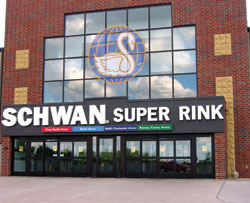 Blaine, Minnesota. Just across the state line in Minnesota, you'll find the largest ice hockey facilities in the world. The Schwan Super Rink at the National Sports Center in Blaine, Minnesota boasts an amazing eight rinks. Listed in the Guinness Book of World Records, this facility offers four Olympic and four NHL-size rinks and an incredible list of amenities, including the Herb Brooks training center, which typically offers coaching to kids as part of tournaments.
Blaine, Minnesota. Just across the state line in Minnesota, you'll find the largest ice hockey facilities in the world. The Schwan Super Rink at the National Sports Center in Blaine, Minnesota boasts an amazing eight rinks. Listed in the Guinness Book of World Records, this facility offers four Olympic and four NHL-size rinks and an incredible list of amenities, including the Herb Brooks training center, which typically offers coaching to kids as part of tournaments.
Blaine is just far enough from the Twin Cities to make traffic a non-issue, but close enough to provide limitless entertainment options and easy access to the airport. Even better, Schwan Super Rink event owners and tournament guests get the full support of the Visit Minneapolis North staff.
"If a team's looking for any extracurricular activities or ideas, we're here to help," says Stephonie Wentz, director of sports, Visit Minneapolis North. "We'll help them plan trips to the Mall of America, the Science Museum, whatever they want. And we'll assist with any site visits, lodging, and even welcome ceremonies and closing parties."
Wentz brings up a good point: when choosing a facility for your next hockey event, consider everything the facility has to offer - number and size of rinks, location, transportation, housing and entertainment for participants- but never forget to take a look at service. Whether you'll need volunteers from local hockey organizations or help from a facility's staff, great service can help turn your tournament into a must-attend event that will grow and succeed for years to come.
--------------------------------------------------------------------------------
A "Miracle" of Hockey Growth in the U.S. Benjamin Jennings. www.NHL.com. Feb. 25, 2000.

